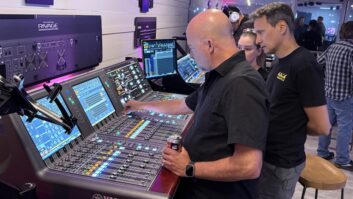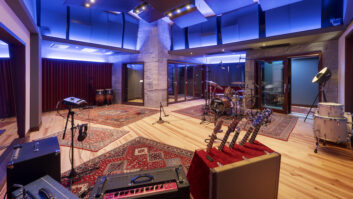
It’s next to impossible to avoid Lili Haydn’s music on streaming services. The violinist and composer has scored the Starz documentary Ruth: Justice Ginsburg In Her Own Words. She also has scored the empowering documentary on pole dancing, Strip Down, Rise Up, out on Netflix, as well as the streaming giant’s popular series Ginny & Georgia. Head over to Spotify, or any DSP, and you’ll find Haydn’s latest artist album, More Love.
These projects have kept Haydn studio-bound for the past year and more, first in a room at a composers’ studio complex where she worked on Ruth and, in part, Ginny & Georgia, then in mid-2020 from her own new home, which she shares with her musician husband, Itai Disraeli. They live in one of those studio homes where every room functions as a recording space. Here, she completed Ginny & Georgia and Strip Down, Rise Up in quick succession during the pandemic.
“We wired the whole house with the Dante network,” says Haydn from what would be considered the “control room” of her Los Angeles home studio, where she has a vocal booth, a machine room and is set up with a big screen, monitors, and both Pro Tools Ultimate HD and Ableton Live. “My husband took the second floor of the house for his studio, and I took the garage. We’re connected so we can share files, and I can record his room. We can record the piano in the living room. I’ve got a little drum room above, as well. We can record everything from everywhere.”
FROM FEATURES TO EPISODIC
While all three of Haydn’s recent screen projects are female-forward, they are very different in character. Ruth is dignified, classical and, to some degree, operatic. Strip Down, Rise Up has changeable moods—most of which are not meant to be directly reflected in the music—and many song replacements. The pop-filled Ginny & Georgia has a number of reference points, including the UK version of Skins, Desperate Housewives, Gilmore Girls and, most interestingly, Dexter, which Haydn determined on her own without the input of the show’s creator. All of the shows have an inordinately large amount of music.
Haydn previously scored Anita: Speaking Truth to Power for writer/director Freida Lee Mock, so tapping her for Ruth was a no-brainer. Conscious to create a score that was distinct from RBG, the 2018 Ruth Bader Ginsburg documentary, Haydn focused on the emotional narrative of Ruth and the triumphant nature of the film. She cites her cue for the closing scene, which supports the complete and utter devotion of its subject, as “stately and intimate,” and one of her best pieces of work.

In contrast, Michèle Ohayan, writer/director of Strip Down, Rise Up, who brought Haydn on after hearing her score for the documentary Feminists What Were They Thinking?, was looking for a fierce and passionate score. In fact, Strip Down, Rise Up had Haydn’s previous score cues as its temp music.
“Temp love can be murderous, even if it’s your own,” Haydn says. “I can’t do better than what I already did. It was about accessing the passion but not being too on-the-nose. Not crying when the women are crying, not being redundant, not stepping on the emotion but supporting it. That takes a lot of trial and error. I did nine versions of some of the big cues.”
Composer Ben Bromfield brought Haydn in as his collaborator for Ginny & Georgia, which after scoring 18 features, is her first series. Show creator Sarah Lampert is said to be hands-on in all aspects of Ginny & Georgia, including the music, which Haydn says can sometimes be hard to pinpoint.
“The tone of Ginny & Georgia is so complicated,” she explains. “It’s not pure comedy, not pure drama, not totally creepy, not really EDM, but it has elements. It had to have this dance between levity and gravitas. Plus, it had all these pop songs, and I wanted the score to be able to move seamlessly between song and score.
“[Bromfield] and I played with a lot of different sounds. We worked with a sound library called Splice—which I cut up quite a bit—for the contemporary pop music element. But we also have acoustic drums and acoustic guitar. I take some of those acoustic sounds and process them so it blurs the line between electronic and acoustic. It’s never just one thing. Even on the more acoustic cues there’s a bunch of processing of sounds with delays and distortion.”
VIOLIN, VOICE AND BLURRING THE LINES
While the violin has been Haydn’s signature instrument since she was in single digits, it is not her only source for ideas and sounds. Piano and vocals are part of the process, too, with Haydn using her voice as the fifth string of her violin.
“I love to sing and play my violin in unison.,” she says, noting that she uses the same microphone and signal chain for her violin as her voice: a Bock Audio 251 into a Brent Averill Electronics 1272 preamp, then into the UA Apollo x8. “While I’m playing, I’m singing the same note. The blend of my voice with the violin is a strange hybrid I really like that I apply quite a lot in my scoring.
“I sometimes sing through my violin,” she continues. “The F-holes are little chambers. On the single ‘More Love,’ there’s a section like a Sgt. Pepper Beatles-y ascending string line. I’m running my violin through a vintage DigiTech Space Station. I’m doing the glissando up the fingerboard with no fret but in two different tracks that are naturally chorused. It has this strange ‘pull your guts out of your mouth’ feel to it. As I’m doing that, I’m also singing through the violin, which I did for ‘Sayonara Pt. 2 (Prayer for Peace)’ on my album.”
When she does use her violin, it’s not always recognizable with the processing and effects she employs. “I have to be very conservative about how much I use my violin, because it’s such a noticeable sound,” she says. “In Ginny & Georgia, my violin is disguised and not preset as a solo voice, except in two episodes. I have to be careful, otherwise it draws attention to itself.
“I struggled my entire life trying to make the violin sound rich and brilliant without hurting your ears,” she continues. “There’s a frequency that’s like daggers to the eardrums. I used to roll off most of the high end in order to not have it shrill, but then it would sound a little too honky or wolf-y. After 20 years I figured out what that frequency is and am able to notch it out at a narrow spike at 3470 (Hz) and then boost around 2k. It makes the violin sound brilliant without sounding painful.”
There are a number of amps, pedals and plug-ins Haydn uses on her violin. The Fender Blues Junior is a favorite, a wah-wah pedal that gives the violin a guitar solo sound or, if she opens the filter a bit, provides a rounder sound that’s easier to blend to create a mystical atmosphere. It’s not just the violin that gets treated, but all the instruments.
For example, the chime-y sound on “Sayonara” on More Love is Disraeli’s bass run through a DigiTech whammy pedal. Also on “Sayonara” is Woody Aplanalp’s guitar through a Chaos pedal, distorted with the violin sound for a cacophony that made for one of Haydn’s favorite moments on the album.

Plug-ins are Haydn’s playground for sound design. Some of her preferred choices include: Output Portal for its granular synth sound; FabFilter Volcano, which she uses to bring sounds in and out of focus in the mix; and UAD Fatso, Distressor, and Ampex ATR-102 mastering tape recorder for character, to go with the Lexicon 224 Atmosphere preset that puts Brian Eno-ish “glue” around everything. She also makes use of the SSL bus compressor and U-he Zebra. All of this is to be able to create sounds without necessarily identifying the sound source.
“With more contemporary picture, you don’t want to know what the sound source is,” says Haydn. “I’ll sing something and I’ll put it through the Faraway preset on Volcano, plus a delay, and it will sound like a woman crying on a distant mountaintop in the hills of Morocco. That’s what I want. I don’t want to know what it is, I just want to feel a little bit of pain.”
The work Haydn has done for screen has a symbiotic dynamic with her artist albums, making them “much more graceful in their ability to play with space and non-space,” she says. “I never had the confidence to let something unfold slowly and organically. [Now] I feel like I’m trusting there is magic that will keep the listener engaged, whereas before I felt like I had to throw something in there to make sure you didn’t lose interest. Part of the skill of composing for film and TV is learning how to keep the viewer interested without stepping on anything.
“The scores I’ve done have come from people liking my albums,” she adds in summary. “The attention I’ve gotten for my albums and the licenses from my songs have come from the scores that I’ve done. They’re very much linked. I wanted to create an album that sounded like me and sounded like the films I wanted to score.”







